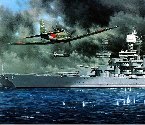Nikademus
Posts: 25684
Joined: 5/27/2000
From: Alien spacecraft
Status: offline

|
"I agree that 1000lb bombs would not cause a great deal of flotation damage, but they should cause a fair amount of system damage. I plastered the Nagato post-bombardment with 12 (!) 1000lbs bombs and 3 500lb bombs and it sunk the next turn. I do not find that entirely disagreeable as the entire super structure and most of the upper decks must have been flaming wreckage. Even given the heavy armor of such a beast, a beating like that should result in either career ending crippling or sinking, especially for Japanese ships whose damage control we all know was not the best. "
Gotta disagree with this. The only "career ending" ever done by bombs alone vs a heavily protected battleship in WWII were uber-bombs such as the 2000ILB AP carried by Stukas against the old Marat in port (mag explosion, she also recieved very little upgrading from WWI and had very thin deck armor) and the use of 12,000ILB "Tallboy" bombs against the Tirpitz and dropped from 10,000 feet.
Arizona and Roma i dont count as the former was hit by converted 16.1 inch AP naval shells from 10,000 feet and Roma was hit by what was in effect the world's first semi-guided missile and the "Fritz" was another very heavy speicimen deployed latewar.
Nagato's vitals were protected by up to 7inches of armor (over mags) and she would have been far from "crippled for life" if hit by a dozen 1000 pounders. Topside damage could have been extensive i agree but this is not a sure thing as even carriers could be hit by 1000ILbers and not always suffer large structural damage.
A good example to look up was the high level bombardment of the Strassbourg by 1,600 ILB semi-AP bombs in 43 or 44 (dont have the source with me) while some damage was caused it was not crippling for life and the armor defeated or localized all of the bombs before detonation. The worst damage was cuts in the electrical system which were certainly repairable.
Battleship Hiei was little effected by bomb hits other than to disrupt work on her already damaged steering engine room (unarmored) and to cause the captain to decide to scuttle in the face of saving crew vs continued pounding. But the ship itself was not turned into a charnel house by additional attacks. The opposite in fact.
A far cry from reducing superstructure and decking to "flaming wreckage" Helldivers failed to stop these brutes at Leyte (both Kurita's as well as the Ise's with the carrier bait force) and also made little impression against the Yamato and Musashi. True they were the ultimate BB's but there superstructure areas were just as unarmored. The point is that a bomb hit will not always result in "flaming wreckage" in the area hit. Sometimes it wont always even result in a fire.
Examples of smaller bomb hits..........(250kg) hits on PoW and Repulse resulted in negligable damage and little to no fire.
"While i have no way to test it, and am not an expert in the rejection characteristics of massive explosions vs. armor...I would imagine that the filler of a 1000lbs bomb when it goes off in contact with armor would certainly blow a fair hole in it. This would spray molten steel through everything beneath it, causing extensive damage and fire (and crew casulties). Anything on the deck for at least fifty feet would be almost certainly vaporized or shocked out of whatever mounting it had unless it was the main turrets, etc. "
No it wouldn't It might "scoop out" or dish in the armor a bit but unless the armor is very thin it will not blow holes in it. The reason for this is because if the bomb detonates on impact before penetrating the armor, a good portion of it's kinetic force will be directed away from the armor. Blast effects will always follow the path of least resistance and a moderate to heavy armor deck will offer the most resistance. This is why AP shells that work properly do more vital damage to a battleship or other armored ship vs one that is either defeated or an HE shell. because the AP shell "punches" through the armor "before" detonating allowing the blast and splinters to do their work in the area being protected as opposed to outside it.
"While this type of spalling and such would not sink a BB a dozen hits like that would render I would guess the top three decks and the whole of the ship above that a total loss. Lucky would the ship be to survive such a beating."
It would either take a very large amount of bombs or some very lucky hits to do this. Ships tend to be much more resilient than that. torpedoes are of course a different story because they strike below armor, cause flooding and because blast effects underwater tend to be magnified in often the path of least resistance for a blast is inside a ship as opposed to the surrounding water.
As an opposite case study, only the Yamato class battleships survived suffering more than 3 torpedoes at sea without either being crippled or sunk.
Now, since it is acknowledged that as an operational strategic game, UV can only do so much detail on the damage level, as a "general rule" SYS damage for non penetrating hits should be kept to a minimal level to reflect the difference and effect that armor makes in rejecting, shielding or localizing damage. This is what seperates the well protected from the Tin-clad. (a small random of course acceptable)
However especially in the case of all HE weapons (shells as well as bombs) there should be good to high chance of fire damage being caused......the bigger the bomb or shell, the greater the chance. Fire at sea is a nasty business and unless quickly brought under control, "it" will end up doing what the bomb couldnt do directly......cause increased SYS, Propulsion and weapons mount damage.
So sticking to bombs only, while they would have little chance of penetrating decks and causing floatation damage (and resulting in a one turn sinking.......not very realistic) they could cause enough fire and light SYS damage that the ship would be forced to beat a retreat back to base for repairs. If the fires go out of control and spread......then like progressive flooding you have a major problem.
As mentioned, left burning long enough you will then see the SYS and weapons damage ala the "Mogami" at Midway......afloat but crippled.
left longer and you have Mikuma.....abandoned to sink or be scuttled.
For this to work though, Fire damage must be a seperate roll from armor penetration and fires need to be reworked so that they do not always automatically get put out regardless of their intensity. This should tie into the damage control factor. (which would be nice if it was variable on a ship to ship basis as some crews were better than others in this regard)
And of course, as a refresher, one should remember too that a bomb can do damage to lightly or unprotected secondary weapons mounts and radar installations so while bombs are not nearly as life threatening to armored ships as torps, they cant be ignored, especially if the ship realistically has to steam back to a major shipyard to repair it. A surface commander who ignores airpower does so at his peril
Going to the complete general, it is usually better to go with conservative 'damage' estimates rather than extreme when dealing with a wargame that must by necessity abstract a good portion of damage to a ship. We see this already with torpedoes as it usually takes more torpedoes than one would expect in alot of situations to sink because the game simply does not have the coding/space to deal with all the variables.....(specific ship design vs underwater damage, TDS, counterflooding, pump capacity, exact location of hit etc etc) however UV makes up for this greatly by including progressive flooding rules which can acomplish the same results only slower by nature of the 24 hour turns. (very deadly for the IJN which doesnt get a bonus to DC)
It is also the same for shells. Obviously even battleships arn't armored everywhere but the game takes the correct course in dealing only with armor vs pen in the stronger areas because for one, the "vitals" are in effect protected by the thickest armor so in general ships in the combat routines will come out much as they did in real life for the most part (seen by myself at least so far in tests......the one exception here is fire damage, esp if small caliber HE shells are being lugged at close range such as in night battles)
It should also be the same for bombs. Yes a bomb can cause massive structural damage at times but more often it will not as it requires the bomb to strike a sensitive area to create such an effect and/or it 'does' need to penetrate the armor to reach a vital/critical compoenent as was the case in the destruction of the battleships Roma, Marat and Arizona.
Another way to look at is all these 'pinpricks' with the occasional lucky hit thrown in, coupled with normal wear and tear will quickly cause a ship to go from 100% operational to being in bad need for repair giving the player the classic dilemma as presented by this type of game. Do i keep a ship in the line? or send it back for refit? Will this ship missing from the lineup be key to a future battle? or will it's presence be more of a handicap or worse, give the enemy a target to sink?
Right now....bombs, without any help from torps which should be the most dangerous weapons on average in the game vs warships, can do the job all by themselves, often in one turn or if IJN, a few turns if they damage the FLT rating enough with all the constant penetrations to make getting back to base an impossibility.
It can be possible to model the lucky hits, but by default, they should be the *exceptions* to the rule, not the rule itself. Right now devastating damage is the rule and must be addressed, either here or in WitP
|
 Printable Version
Printable Version














 New Messages
New Messages No New Messages
No New Messages Hot Topic w/ New Messages
Hot Topic w/ New Messages Hot Topic w/o New Messages
Hot Topic w/o New Messages Locked w/ New Messages
Locked w/ New Messages Locked w/o New Messages
Locked w/o New Messages Post New Thread
Post New Thread